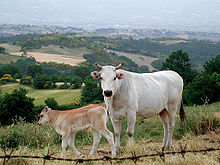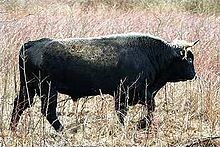Taurus Project



Taurus cattle are an advanced form of Heck cattle, an attempt of breeding back the aurochs, the wild ancestor of domestic cattle. They are the result of crossbreeding traditional Heck cattle with aurochs-like cattle mostly from Southern Europe to achieve a greater resemblance to the aurochs and larger body size. Taurus cattle herds are located in Germany, Denmark, Hungary and Latvia and are used in conservation of natural landscapes and biodiversity.[1] Taurus cattle is a breed that is still being crossbred and selected.
History
In 1996 the conservation group Arbeitgemeinschaft Biologischer Umweltschutz in Germany started to crossbreed Heck cattle with primitive cattle from Southern Europe such as Chianina, Sayaguesa Cattle and the Spanish fighting bull in the Lippeaue reserve near the town of Soest. The purpose was and is an increased resemblance to the extinct aurochs, because they considered Heck cattle not satisfying. For example, they write in one of their publications: ″The ′recreations′ by the Heck brothers are too small, too short-legged, not elegant and their horns are not satisfying″.[2] Therefore the goal is to breed cattle that are considerably larger, more long-legged and long-snouted and have horns curving forwards additionally to the wild type colour scheme that was already present in the population.[3][4] By 2003 the breeding process had advanced enough to consider the animals a breed in their own right; as breed name, Taurus cattle was chosen.[5] Also in 2003, a breeding herd each was started in Hungary and Denmark, in 2004 one was begun in Latvia.[1]
Germany
In Germany, Taurus cattle herds are crossed with Chianina and Sayaguesa, two very tall breeds, and initially also the Spanish fighting bull (Toro de Lidia). The crossbred animals in the Lippeaue reserve, the most important breeding location, are composed of 47% Sayaguesa, 29% Heck cattle, 20% Chianina and 4% Lidia on average.[6] Some individuals are of the fifth cross generation already.
Taurus cattle are listed in the herdbook X of the German Heck cattle association VFA. There is an increasing interest of Heck cattle breeders in using Taurus cattle because of their larger resemblance to the aurochs, so that there is a continuum between Taurus cattle and un-crossed Heck cattle.[3]
Hungary
Hortobágy National Park in Hungary has the largest herd of Taurus cattle so far, counting approximately 200 individuals. Additionally to crossbred cattle that were imported from Germany, Ankole-Watusi, Hungarian Grey cattle crosses and one half-Holstein Friesian cow are used.[7] There are two sub-herds, a main herd at Pentezug and another one at Karácsonyfok.[8] Studies in the national park showed that cattle are less adapted to dry, cold grassland than Przewalski horses, and until a few years ago the cattle were supplementary fed.[8][9] The winter of 2011, however, was the first winter in which additional food was not necessary.[10]
Denmark

Taurus breeding was initiated in Lille Vildmose Nature Reserve under the name Projekt Urokse ('Project Aurochs').[11] The founding herd consisted of one Chianina × Heck bull, four Heck cows and one Sayaguesa × Heck cow, and in 2009 three Sayaguesa bulls were added. As of 2010, the herd had grown to a size of 56 individuals.[12]
Latvia
In Latvia, Taurus cattle are being bred by WWF Latvia.[1] In February 2004, besides two German animals 21 head of Dutch Heck cattle were brought to Pape Nature Reserve,[13] in October another 18 head of Dutch Heck cattle followed.[14]
External features

Most Taurus cattle are long-legged and comparatively slender. An increase in size was achieved, large Taurus bulls measure 160–165 cm at the withers while normal Heck bulls measure only 140 cm.[3] Most bulls are black with a light dorsal stripe, some bulls have a light colour saddle. Cows are on average, but not always, a lighter colour than the bulls, most of them are coloured reddish brown or dark brown. Some cows are as of yet still greyish or beige, an undesirable legacy of Heck and Chianina influence. The horns of most Taurus cattle face forwards and also more inwards compared to un-crossed Heck cattle, but the exact curvature of the horns is variable to a certain degree. The skull is longer and more straight-profiled than that of Heck cattle, and therefore resembles the aurochs. Usually, Taurus cattle have a more athletic body than Heck cattle do, and their shoulder muscles are more developed.
Gallery
Lippeaue
-
″Larissa″: Chianina × (Sayaguesa × (Heck × Chianina))
-
″Latino″: 50% Sayaguesa, 25% Fighting cattle, 25% Heck
-
bull ″Larwin″ (centre): 50% Sayaguesa, 37,5% Heck, 12,5% Chianina; cow at right: Heck × Sayaguesa
Hortobágy
-
Sayaguesa-influenced cow
-
Watusi-influenced cow
-
″Toldi″: 75% Heck, 25% Sayaguesa
-
″Szepes″: 75% Heck, 25% Sayaguesa
External links
- Margret Bunzel-Drüke, Edgar Reisinger: Taurus cattle. A stand-in for the aurochs. 2010. Pdf of ppt. Retrieved 24 May 2014.
References
- ^ a b c Margret Bunzel-Drüke: ″Projekt Taurus – En økologisk erstatning for uroksen.″ Translated into Danish by Karsten Thomsen. Lohne: ABU 2004; Århus: Nepenthes, 2005. Template:Da icon
- ^ ABU info 06/07: Bunzel-Drüke, Scharf & Vierhaus: ″Lydias Ende – eine Tragikomödie.″ ABU info 30/31 (2006/07), pp. 58–67. Template:De icon
- ^ a b c Bunzel-Drüke, Finck, Kämmer, Luick, Reisinger, Riecken, Riedl, Scharf & Zimball: Wilde Weiden: Praxisleitfaden für Ganzjahresbeweidung in Naturschutz und Landschaftsentwicklung. ABU 2008. ISBN 978-3-0002-4385-1
- ^ Cis van Vuure: History, Morphology and Ecology of the Aurochs (Bos primigenius). 2002.
- ^ Marcel Keiffenheim (text), Lin Lambert (pictures): ″Das Ur-Viech.″ Greenpeace Magazin (Germany) 5.03. Template:De icon
- ^ Internationales Zuchtbuch für Heckrinder
- ^ Walter Frisch: Der Auerochs – Das europäische Rind. 2010, ISBN 978-3-00-026764-2.
- ^ a b Waltraut Zimmermann, Lydia Kolter, Istvan Sandor: ″Naturschutzprojekt Hortobagy – Jahresbericht 2003.″ Zeitschrift des Kölner Zoo 2004. Template:De icon
- ^ Julia Poettinger: Vergleichende Studie zur Haltung und zum Verhalten des Wisents und des Heckrinds. 2011. Template:De icon
- ^ Waltraut Zimmermann, Lydia Kolter, Istvan Sandor: ″Naturschutzprojekt Hortobagy – Jahresbericht 2011.″ Zeitschrift des Kölner Zoo 2012. Template:De icon
- ^ Projekt Urokse – A pilot project from Lille Vildmose National Park pdf. The Amt of Northern Jutland. 2005. Retrieved 26 November 2013. Template:Da icon
- ^ Uffe Gjøl Sørensen: Vildokserne ved Lille Vildmose 2003–2010. Status rapport med anbefalinger til projektets forvaltning. København: UG Sørensen Consult, 2010. Retrieved 26 November 2013. Template:Da icon
- ^ Tauru pēcteči atgriezušies Papes pļavās! www.tvnet.lv, 4 March 2004. Retrieved 24 May 2014. Template:Lv icon
- ^ Ierodas 24 jauni dzīvnieki - savvaļas zirgi un tauri. www.tvnet.lv, 14 October 2004. Retrieved 24 May 2014. Template:Lv icon








